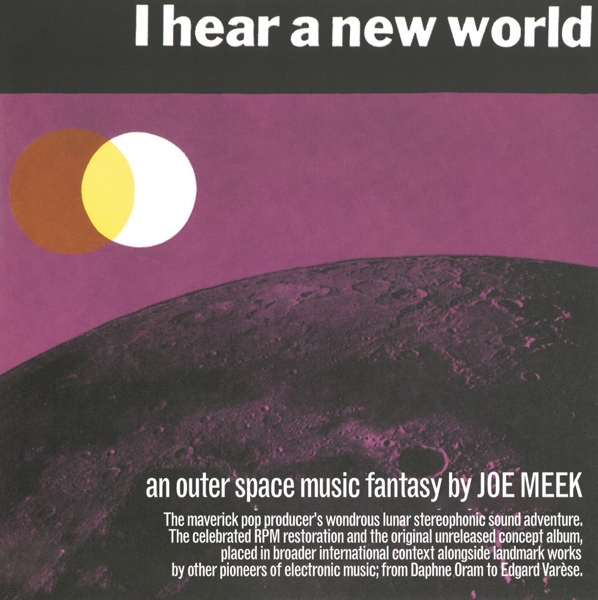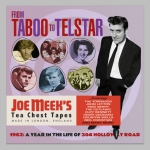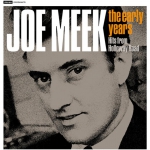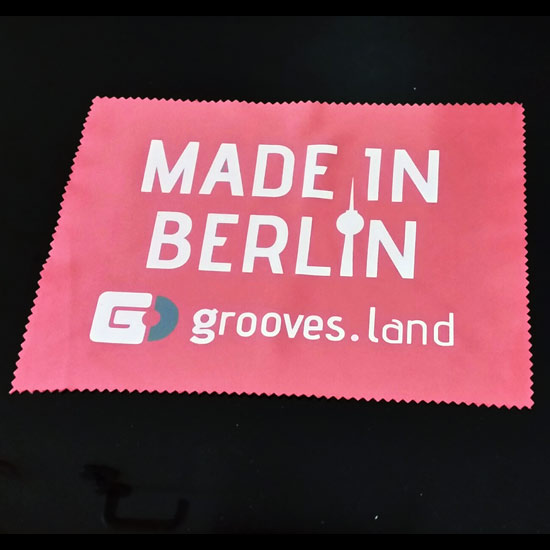Your search:
No selection
Filter results:
|
Other products from Joe Meek |
| Details / Tracklist: |
1.1 I Hear a New World1.2 Orbit Around the Moon1.3 Entry of the Globbots1.4 The Bublight1.5 March of the Dribcots1.6 Love Dance of the Saroos1.7 Glob Waterfall1.8 Magnetic Field1.9 Valley of the Saroos1.10 Dribcots Space Boat1.11 Disc Dance of the Globbots1.12 Valley of No Return1.13 I Hear a New World1.14 Glob Waterfall1.15 Entry of the Globbots1.16 Valley of the Saroos1.17 Magnetic Field1.18 Orbit Around the Moon1.19 The Bublight1.20 March of the Dribcots1.21 Love Dance of the Saroos1.22 Dribcots Space Boat1.23 Disc Dance of the Globbots1.24 Valley of No Return1.25 Amphitryon 38 - Daphne Oram1.26 The Artist Speaks - Phil Young1.27 Science and Industry - Phil Young and Maddalena Fagandini1.28 Interval Signal - Maddalena Fagandini1.29 Time Beat - Maddalena Fagandini1.30 Ideal Home Exhibition - Maddalena Fagandini1.31 The Chem Lab Mystery - Maddalena Fagandini1.32 Time on Our Hands (Titles and City Music) - Delia Derbyshire1.33 Arabic Science and History - Delia Derbyshire1.34 Time Beat - Ray Cathode (Maddalena Fagandini - George Martin)1.35 Waltz in Orbit - Ray Cathode (Maddalena Fagandini - George Martin)2.1 Dripsody (An Etude for Variable Speed Recorder) - Hugh Le Caine2.2 Syncopation (Orbit Aurora) - Tom Dissevelt2.3 Whirling (Sonic Re-Entry) - Tom Dissevelt2.4 Drifting (Moon Maid) - Tom Dissevelt2.5 Fantasy in Space - Otto Luening2.6 Piece for Tape Recorder - Vladimir Ussachevsky2.7 Étude 1 Sur Un Son2.8 Étude 2 Sur Un Accord de Sept Sons2.9 Timbres Durées - Olivier Messiaen2.10 Sound in Unlimited Space - Herbert Eimert ; Robert Beyer2.11 Studie NR.1 - Karlheinz Stockhausen2.12 La Rivière Endormie - Darius Milhaud2.13 Interpolation 1 from Déserts - Edgard Varèse2.14 Spirale - Pierre Henry2.15 Étude Aux Sons Animés - Pierre Schaeffer3.1 Poeme Electronique - Edgard Varèse3.2 Scambi - Henri Pousseuri3.3 Musica Su Due Dimensioni "Dimensioni No. 1" (Version for Flute and Tape) - Bruno Maderna3.4 Fontana Mix - John Cage3.5 Artikulation for Tape - György Ligeti3.6 Part One3.7 Part Two3.8 Part Three3.9 Orient Occident la Prisonnière - Iannis Xenakis3.10 Momenti, for Magnetic Tape - Luciano Berio3.11 Visages (Excerpt) - Luciano Berio3.12 The Innocents - Savage Noises (Excerpt) - Daphne Oram3.13 Rhythmic Variation 1 from Electronic Sound Patterns - Daphne Oram |
 | | Number of discs: |
3 |
 | | Regioncode: |
0 What's that?
Please note our information regarding region codes:
DVDs and Blu-Rays often are country encoded and do not play worldwide. Please check whether your player is compatible with the area code of the item.
DVD code - Area
0/free - Informal term meaning "worldwide"
1 - United States, Canada, Bermuda, U.S. territories
2 - Europe (Central Europe, Northern Europe, Southern Europe, Western Europe), Egypt, Middle East, Japan, South Africa, Swaziland, Lesotho, Greenland, British Overseas Territories, British Crown Dependencies, French Overseas departments and territories
3 - Southeast Asia, South Korea, Taiwan, Hong Kong, Macau
4 - Latin America (except French Guiana), Guyana, Suriname, New Zealand, Australia, Papua New Guinea, much of Oceania
5 - South Asia, Afghanistan, Eastern Europe (Ukraine, Belarus, Russia, Kazakhstan), Africa (except Egypt, South Africa, Swaziland, Lesotho), Central Asia, Mongolia, North Korea
6 - China
7 - Reserved for future use, MPAA-related DVDs and "media copies" of pre-releases in Asia
8 - International venues such as aircraft, cruise ships, spacecraft, etc.
9 - all eight flags set, allowing the disc to be played in any location, on any player
Blu-Ray Code - Area
free/0 - Informal term meaning "worldwide".
A/1 - United States and their dependencies, East Asia, and Southeast Asia; excludes instances that fall under Region C.
B/2 - Africa, Middle East, Southwest Asia, most of Europe, Australia, New Zealand, and their dependencies; excludes instances that fall under Region C.
C/3 - Central Asia, mainland China, Mongolia, South Asia, Belarus, Russia, Ukraine, Kazakhstan, Moldova, and the aforementioned regions' dependencies.
|
 | | Extra-Infos: |
.. The Pioneers Of Electronic Music |
 | | Description: | I Hear A New World / The Pioneers Of Electronic Music by Joe Meek, released 20 September 2019, includes the following tracks: "Entry Of The Globbots", "March Of The Dribcots", "Glob Waterfall", "Valley Of The Saroos" and more.
This version of I Hear A New World / The Pioneers Of Electronic Music comes as a 3xCD. - .. THE PIONEERS OF ELECTRONIC MUSICA presentation featuring Joe Meek's fantastical lunar stereophonic sound adventure, I Hear A New World; both the celebrated 1991 RPM restoration and the original unreleased 1960 concept album; placed in broader international context alongside seminal works by other pioneers of electronic music; from Daphne Oram to Edgard Varèse. Considered in this context, Meek's masterpiece seems less an oddball pop novelty than a daring and visionary electronic sound exploration. The legendary British pop producer came to prominence during the repressed monochrome days before the Beatles arrived to change everything; an era of fascination with all things Space Age and nuclear; a mood Meek encapsulated with his biggest hit, Telstar by the Tornados; a million selling chart-topper on both sides of the Atlantic and the first British pop single to reach Number One in America. Electronic gear and studio techniques were Meek's obsession. He would dismantle a piece of equipment and modify it in order to ramp up it's capability and thought nothing of building his own compressors, equalisers and echo units. The trademark Meek sound combined an extra-terrestrial keyboard, brittle guitars awash with reverb and a spectral vocal all fiercely compressed. He constantly pushed at the frontiers of his studio's technical potential, using it as an instrument in it's own right and often applying authentic musique concrète procedures in the perpetual search for new sounds. His knowledge of electronics was as advanced as anyone in Britain at the time. The establishment record labels were intimidated by Joe's inventive genius and moody eccentricity; embarrassed that he could outdo them by producing hit records from a glorified home studio above a leather goods shop on the Holloway Road. Meek's emergence coincided with the advent of stereo sound and investigations by serious composers into the artistic potential of electronic technology. There was great enthusiasm for the new medium in part because the composer was no longer dependent on the interpretation of the performer. Electronic studios were founded across Europe; in Paris, Cologne, Milan and Eindhoven, at radio stations or research laboratories where the necessary technology was already available. Pierre Schaeffer's studio for musique concrète in Paris was the first, attracting Boulez, Messiaen, Milhaud, Stockhausen and Varèse, but these composers were frustrated at Schaeffer's emphasis on the manipulation of everyday sounds rather than those that were electronically generated. On the other hand, the Studio for Electronic Music of the West German Radio in Cologne, founded by Herbert Eimert & Robert Beyer and eventually dominated by Stockhausen, set up in opposition to Paris and in favour of music generated exclusively by electronic means. At Radiotelevisione Italian in Milan the composers Bruno Maderna and Luciano Berio embraced and went beyond both disciplines. John Cage flew in to visit the facility and create the dizzying blur of sound that is Fontana Mix and win a local TV quiz show on his specialist subject 'poisonous and edible mushrooms'. At the Philips Research Laboratories in Eindhoven, Tom Dissevelt and his assistant Kid Baltan (Dick Raaymakers) conducted their interplanetary sound experiments on the fringes of pop, only marginally to the left of Meek. In London, the BBC Radiophonic Workshop assembled a team of gifted composers including co-founder Daphne Oram, Madallena Fagandini and Delia Derbyshire to create sound effects, rhythmic interval signals and music for radio and television productions. Their work was created anonymously at the service of the corporation, nevertheless it came to the attention of the head of Parlophone Records and soon to be Beatles producer, George Martin who collaborated with Fagandini to make a catchy single of Time Beat: "Electronic music - that slightly disturbing sound of our times which is produced amid a complex of tape recorders and electric wiring - is about to attack the hit parades. " exclaimed one newspaper. Between 1964 and 1967 pop music changed more radically than it had in all the years since it's inception in the 1950s and the long playing record became it's main product. Once the Beatles determined to devote themselves to working in the studio with George Martin on music with increasingly ambitious, conceptual themes, it was inevitable that they would need to be able to draw on a wider and more eclectic range of materials. Paul McCartney chose to engage with electronic art music of Berio and Stockhausen, attending lectures and performances of their work in London. Their influence opened up a new world of sonic possibilities for the Beatles that can be heard in the backward tape echo, vocal manipulations, loops and sound collages of Tomorrow Never Knows, Strawberry Fields Forever, Penny Lane and I Am the Walrus, culminating in Revolution 9 which has been described as "the world's most widely distributed avant-garde artefact. "Clamshell Box set with 3 discs in individual sleeves
24 Page booklet
1-1 to 1-12 originally released as [r=1234694]
1-13 to 1-24 originally appeared as [r=19968004]
1-34 & 1-35 originally released as [r=250067] |  | | No. of tracks: |
63 |
 | | Manufacturer No.: |
ACME349BOX |
 | Product Safety
Responsible Person for the EU:
tonpool Medien GmbH
Im Klint 12, 30938 Burgwedel, DE
info@tonpool.de |  |
|
There are currently no product reviews.
|  |
|
|
 |
|


















![Camel - Music Inspired by the Snow Goose 2CD+Blu-ray Box S [DE-Version, Regio 2/B]](https://img.grooves.land/images/cover/074/949/f6bwvs28.j11)







